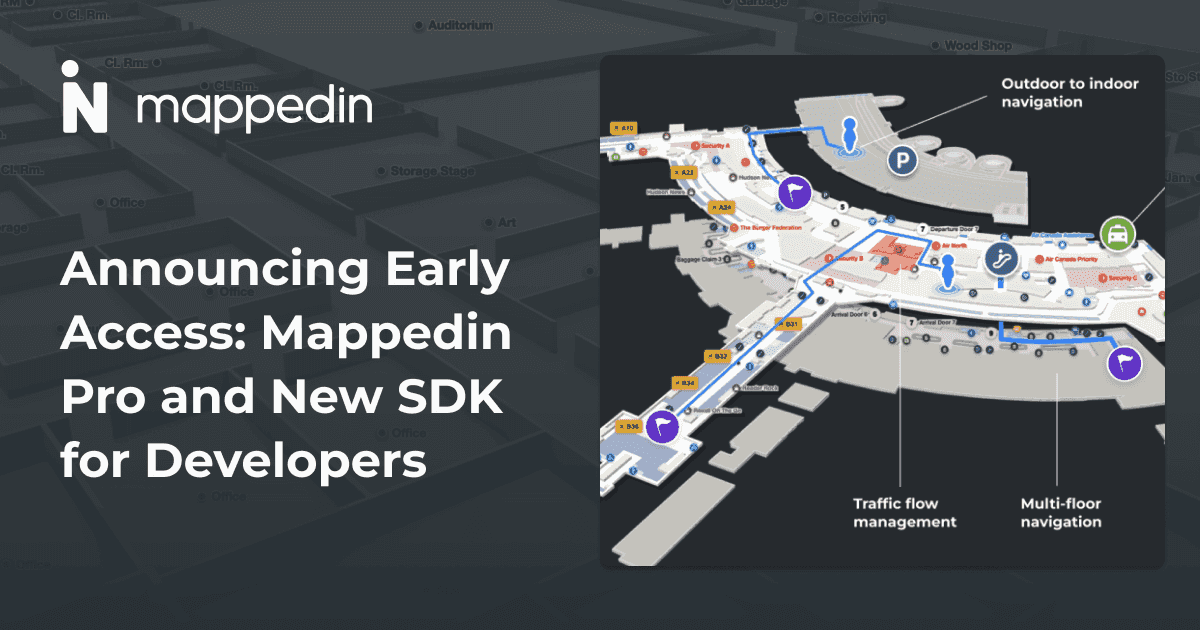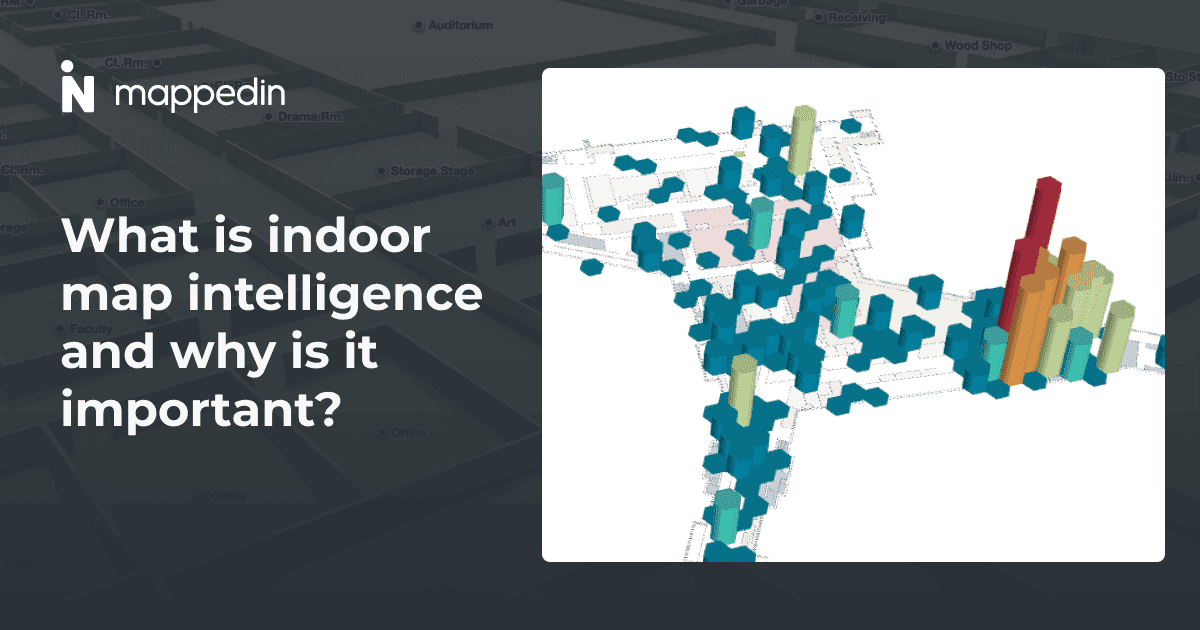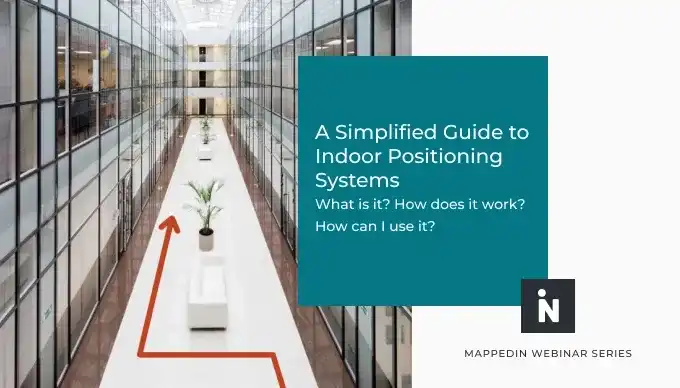In this guide, we'll discuss what an indoor positioning system is, how it works, what it's used for, and how to find the right solution for your business.

What is indoor positioning?
An indoor positioning system (IPS) can be thought of as a global positioning system (GPS) for indoor spaces. Using a variety of methods, these systems can determine the precise location of people or assets within a building in real-time.
What is the difference between indoor mapping and indoor positioning?
Indoor positioning and indoor mapping are different but complementary services. Indoor mapping helps you visualize what an indoor space looks like, while indoor positioning helps you accurately place yourself within a defined indoor map. Without an indoor map, indoor positioning is rendered nearly useless for any visualization purposes.
Indoor positioning systems and indoor navigation
Indoor positioning is often confused with indoor navigation. Paired with an indoor map, indoor navigation provides spatial context and directions from Point A to Point B, while indoor positioning enables you to view your current position as you follow directions. Typically, your indoor location is represented visually by a blue dot that follows you around in real-time and provides navigation cues as you move through an indoor space.

What is it used for?
Indoor positioning systems are used for a variety of applications, including tracking items in warehouses; providing guidance for navigating malls, airports, and complex indoor spaces; monitoring the location of valuable assets; tracking the current location of medical or emergency personnel, and more.
Benefits of indoor positioning systems
The benefits don’t stop there. As discussed in our How to Use Indoor Positioning Analytics to Benefit Your Business blog, companies can use indoor positioning data and analytics to identify potential areas for investment, analyze areas of high (or low) foot traffic with heat maps, or can implement proximity marketing to target customers with personalized deals and promotions.
Who uses indoor positioning solutions?
Indoor positioning solutions are used by businesses and organizations in a variety of industries, including warehousing, healthcare, transportation, retail, logistics, and more. They can be used to track personnel and assets in real-time as well as to provide guidance to help users navigate indoor environments.
Use cases for indoor positioning solutions
As mentioned previously, there are several use cases for indoor positioning. Let’s explore some of them in greater detail.
Asset location
Indoor positioning systems are often used to track assets, such as warehouse items or equipment in an office building, in order to gain visibility into their whereabouts and optimize efficiency. This can help businesses save time and money by optimizing storage utilization, providing more accurate indoor tracking of inventory levels, and reducing operational costs associated with manually counting and searching for assets.
Enhanced indoor navigation
Indoor positioning systems enhance indoor navigation due to its ability to provide accurate, real-time guidance within a physical environment, such as an office building, through the use of beacons. This allows users to view their current position on an indoor map and easily find their way around by following intuitive directions.

Monitoring & security
Since indoor positioning can accurately track the current location of people and objects in real-time, it proves useful for monitoring and security purposes. This technology is especially beneficial in secure areas, where unauthorized access needs to be prevented, as it allows these areas to be monitored at all times. Additionally, IPS can help with asset tracking and management to ensure that any suspicious activity is detected promptly.
Build your own solution
By pairing indoor positioning technology with your indoor map, you can unlock a wide range of solutions for your indoor space. Do you have an idea in mind? Reach out to us, we’d be happy to help bring your vision to life.
Indoor positioning solutions
Let’s explore indoor positioning a bit further. How does it work and what kind of technology is used to see the current location of assets and people in a building?
How it works
A large variety of techniques and devices are used to provide indoor positioning ranging from reconfigured devices already deployed such as mobile devices, Wi-Fi, and Bluetooth; to purpose-built installations with beacons that are strategically placed throughout an indoor venue.
What kind of technology Is used?
There are a variety of indoor location technologies that can be used for indoor tracking, including beacons, Wi-Fi, RFID, and geomagnetic.
Finding the right solution for your business
There are many indoor positioning systems available today. To find the provider that is best suited for your business, it's important to understand what you want to use these real-time location systems for and ensure you have an indoor mapping foundation to visualize these systems on top of.
How MappedIn works
Mappedin is the leading platform for indoor spatial data management, digitizing venues, and building best-in-class indoor mapping experiences. Built for scale, our flexible platform enables you to build indoor mapping solutions for any use case, and layer on additional experiences with indoor positioning. Mappedin offers infrastructure-free indoor positioning with Apple and has several partnered providers to choose from, depending on your unique needs.

Indoor positioning solutions FAQs
Let’s address some of the frequently asked questions about indoor positioning solutions.
Why is indoor positioning so important?
Indoor positioning provides valuable solutions for many businesses and industries. It provides precise navigation to help users find the products and services they’re looking for, enables indoor tracking for property managers to monitor the current position of personnel, objects, and assets within buildings, and enables businesses to gain insights into how their indoor spaces are being used, among other applications.
Why should you invest in an indoor positioning solution?
You should consider investing in an indoor positioning system because it can provide a variety of benefits, such as:
- Improved customer experience through accurate navigation
- Ability to track assets and understand operations more efficiently
- Personalization of offers and experiences tailored to customers’ current location
- Enhanced safety, security, and compliance measures within a building
What are the best indoor positioning technologies?
There are several indoor location technologies to choose from. Watch our webinar to learn more about all things indoor positioning, and contact us to find the right indoor positioning technology for your specific use case.
Tagged In
Share


